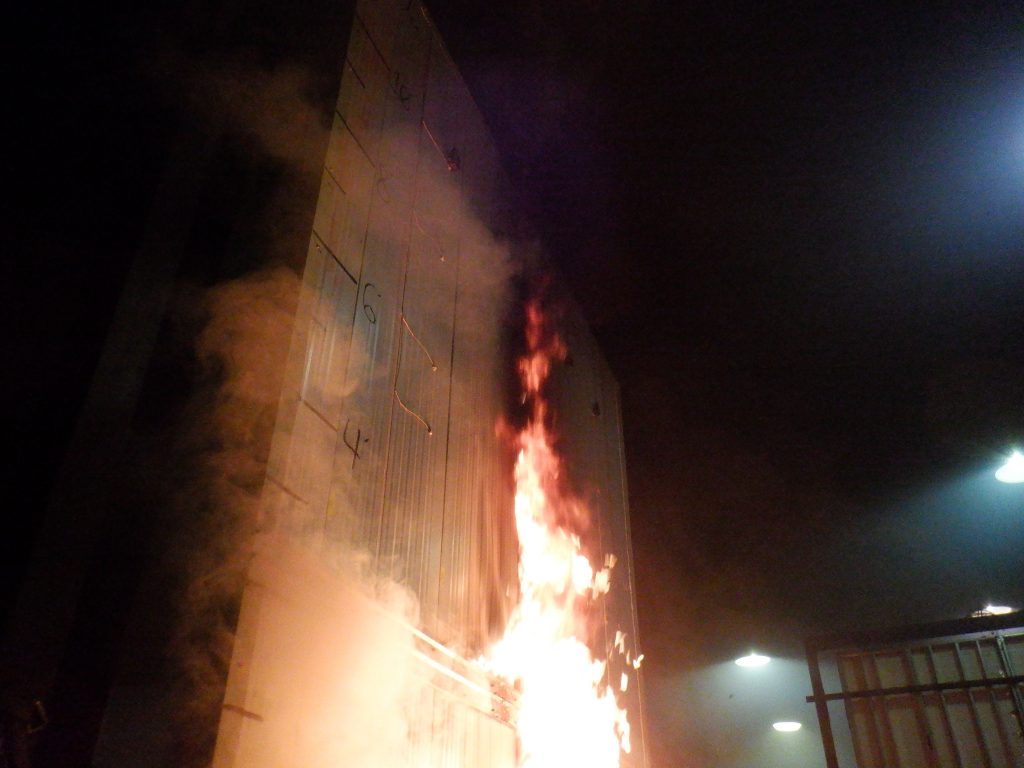For the past 20 years, the National Fire Protection Agency’s NFPA 285 testing standard has been lending a certain level of assurance that tested assemblies could withstand a fire event.
Now, building assemblies passing the updated NFPA 285-19 Standard Fire Test Method for Evaluation of Fire Propagation Characteristics of Exterior Wall Assemblies Containing Combustible Components can offer even greater assurance of fire protection to specifiers and building owners.
Whereas the original standard contained less specific language as to the design of the test assembly, the updated standard now mandates that assemblies, such as insulated metal panels (IMPs) that contain foam plastic insulation, be tested with side and end joinery and in various configurations to better reflect the various ways the product is applied.
“The new test standard ensures what is tested is more representative of what is constructed,” explains Mark Klos, Director R&D, Metl-Span.
More specifically, the new language incorporated into NFPA 285-19 states that horizontal panels be tested horizontally, and vertical panels be tested vertically, both incorporating representative joinery at specified locations.



Metl-Span IMP Testing
Even though NFPA 285-19 won’t become an enforceable standard until states adopt the 2021 International Building Code, Metl-Span’s sense of responsibility for the safety of its products led the company to work on testing its IMPs once the new standard was released.
“We felt it was important to do this test in advance of any jurisdictional requirement,” Klos explains.
While one-story structures and buildings less than 40 feet in height are generally exempt from NFPA 285 testing, when utilizing a combustible material in non-combustible construction, Klos believes that large-scale fire testing is vital to understand the way a product functions in a fire event.
“The testing gives assurance to the design community and to owners that Metl-Span IMPs have been proven to perform in fire conditions modelled similar to their end use,” he states.
“Managing a fairly wide portfolio of IMP systems ranging from 2 inch to 8 inch in thickness, and 24 inches to 42 inches in width, requires a coordinated effort with the listing agency. Our decades of experience in all varieties of fire testing provides the confidence to work efficiently with listing bodies and provide a similar sense of confidence to our customer.”
The Test
The NFPA 285-19 fire test is constructed as a full-scale, two-story wall assembly with a first story window opening. The test lasts 30 minutes with an increase of heat input occurring at five-minute intervals. A fire source is placed in strategic locations and thermocouples are used to measure temperature. For the test specimen to pass, the following conditions must be met.
- Flames are not visually observed on the exterior wall 10 feet or higher above the window head or 5 feet or greater laterally from the center of the window opening.
- The exterior thermocouples located 10 feet vertically and 5 feet laterally from the window opening do not exceed 1,000°F.
- Temperature rise does not exceed 1,000°F within any wall cavity air space.
- Temperature rise does not exceed 750°F within any combustible wall components more than ¼ inches thick.
- Temperature rise does not exceed 500°F within the second-story test room, measured 1 inch from the interior wall assembly surface.
- Flames are not visually observed within the second-story test room.
Klos explains that the heat of the fire not only attempts to ignite and consume the foam core, but also creates expansive forces in the metal skins that must be constrained. This is the primary challenge to a successful outcome to fire testing wide, thin light gauge insulated metal panels.

Advantage of IMPs
It’s important to note that NFPA 285-19 is an assembly test, which means that all components must be tested together to be compliant. Consequently, IMP systems offer a great advantage as an all-in-one enclosure system.
With other systems and materials, architects are challenged to combine individual manufacturers’ tests of various components, barriers, insulation, sheathing and cladding in an attempt to assemble a compliant system. In many cases, this isn’t possible, and the proposed design requires a project specific NFPA 285 test.
Because an IMP provides both an inside and outside surface, it must also pass NFPA 286 testing for interior ignition. And beyond fire resistance testing, because they are designed as a single-component building envelope solution, IMPs are required to pass a battery of water, air infiltration, thermal and structural tests.
Based on the high level of regulation that products containing foam plastics must meet for compliance in the U.S. market, a high level of confidence is imparted to architects that the Metl-Span panels they are specifying will perform well under a variety of conditions and events.
Have Questions About Our Products?
Please fill out the following information and an experienced sales representative will be in contact. We look forward to hearing from you!
View our Privacy Policy
